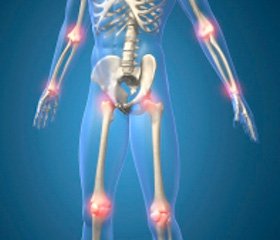Журнал «Травма» Том 16, №4, 2015
Вернуться к номеру
Obesity-Induced Osteoarthritis: the Multifactorial Interrelation and the Leading Role of Adipokines, Dyslipidemia and Mechanical Loading
Авторы: Golovach I.Yu.
Clinical Hospital «Theophania» of Department of State Affairs, Kyiv, Ukraine
Рубрики: Травматология и ортопедия
Разделы: Клинические исследования
Версия для печати
osteoarthritis, obesity, adipokines, dyslipidemia, pathogenesis.
The article covers current data and recent studies on the connection between the obesity, osteoarthritis (ОА) and аdipokines. Obesity is a well-known risk factor for the development of osteoarthritis. The link between extra weight and osteoarthritis is not limited by the increased joint stress caused by obesity. However, the interrelation between the obesity and OA in non–weight-bearing joints suggests a more complex aetiology for the obesity-induced OA. Adipose tissue is currently considered to be an endocrine organ that produces substances with local and systemic effects. Obesity adipose tissue contains a large amount of dendritic cells, T- and B-cells, and macrophages. They secrete hormones, cytokines and signaling molecules that regulate numerous biological processes and maintain low level of inflammation in adipose tissue. The best-known аdipokines are leptin, adiponectin, resistin and visfatin, the role of which in the pathogenesis of osteoarthritis and other rheumatic diseases is discussed extensively. Adipokines may influence articular cartilage in different ways. On one hand, they raise the level of proinflammatory factors, on the other hand they have anti-inflammatory potential. In addition, obesity is related to the impaired lipid metabolism, which leads to systemic low high-density lipoprotein (HDL) and high levels of free fatty acids (FFA), triglycerides (TG) and oxidized LDL. Particular attention is paid to the excessive load effects on the subchondral bone. It was found that any abnormal mechanical stress — tension, compression, bias voltage, the hydrostatic pressure — can be converted into intracellular signals via excitation of mechanoreceptors located in the superficial layers of articular cartilage. Continuous load leads to phenotypic changes of osteoblasts and chondrocytes and the formation of so-called "inflammatory" phenotype of cells producing a significant amount of pro-inflammatory cytokines and growth factors. Subsequently, the effects of a disturbed lipid metabolism, low-grade inflammation, and adipokines on joint tissues are discussed and linked to OA. Thus, the association between obesity and osteoarthritis beyond the mechanical loading and generates separate clinical-pathogenic phenotype of the disease. The paper emphasized the importance of understanding of the role of obesity in the development of OA. Firstly, the weight loss in obese patients reduces strain on joints and can significantly reduce the risk of OA in the supporting joints. Secondly, a low-fat diet should be recommended to all patients with OA. Thirdly, the therapy aimed at adipokines blockade in OA and cytokines can be a useful strategy. Therefore, anti-cytokine drugs and possibly leptin inhibitors may eventually become an important part in the regimens of OA.

